8 traditional Catholic wedding customs (and 1 that isn’t)
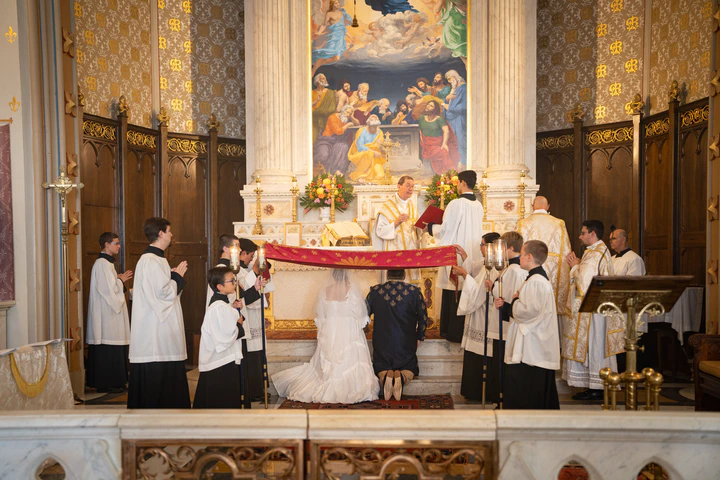 A nuptial veil (velatio nuptialis), photo reused with permission from Catherine Asija (2022)
A nuptial veil (velatio nuptialis), photo reused with permission from Catherine Asija (2022)One of the questions foremost in the minds of Catholic couples is what wedding customs are actually traditional, and what are (dare I say) accretions?
Wedding customs and rituals, highly regionalized, as unregulated by Rome as possible, are a tricky animal. It’s the usual conundrum: if tradition is what came before, and we’ve had several consecutive generations deviate from the tradition, what’s more traditional? Doing what your parents did, or doing what 5 generations back did?
We shall leave a full exploration of such questions to keyboard amateur liturgists. Instead, I’d like to share eight Roman Catholic wedding customs throughout history - and one custom that is not traditional.
1. Betrothal

Caption: Smith, Reverend Matthew. “Church Has Special Way for Betrothing of Couples.” The Register (Denver, CO), June 3, 1928. https://archives.archden.org/islandora/object/archden%3A5440
Betrothals have surged in popularity lately, and are a delightful custom with a rich history1. The rite is not universally standardized, and fairly simple in its requirements. The engaged couple meets with their priest and some witnesses in a church, the priest blesses their engagement, and some readings are read.
2. Veni Creator

Caption: chant notation for Veni Creator Spiritus
The Missa pro Sponso (introit: Deus Israel conjugavit) was set down as the votive Mass for weddings by the Council of Trent. Before Trent, it was common to have slight regional variations in the readings. For example, medieval England sometimes used the Mass of the Holy Trinity for wedding Masses. In the same vein, some regions2 sang the Veni Creator during the wedding rites. The Veni Creator is also sung when laying the foundation stone for a church - a fitting image for marriage3. One of the oldest and most beloved hymns, made more famous by the Carmelites of Compiegne singing when they went to their execution, there is a lifetime’s worth of meditation material when thinking about the Holy Ghost and marriage.
The names and virtues of the Holy Ghost - peace, love, understanding, refining fire, the Comforter - could not be more fitting for marriage. Read Father Vincent McNabb’s beautiful meditation here4.
3. Exhortation
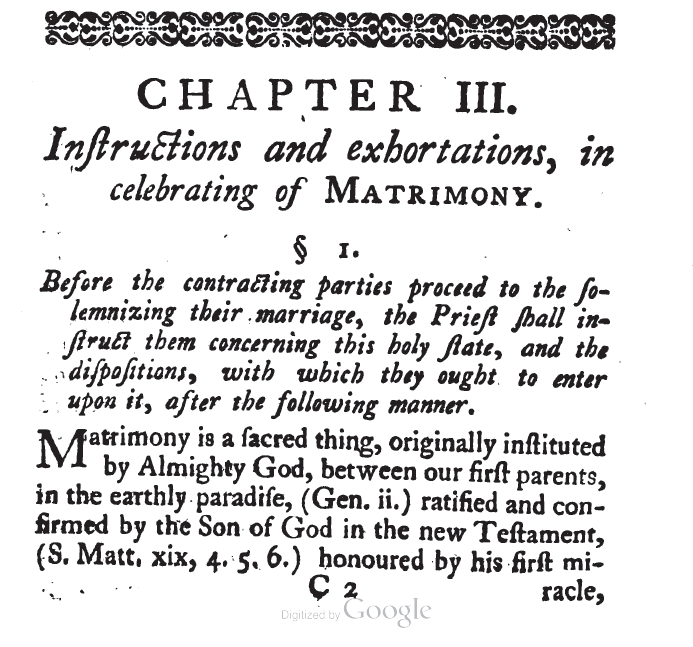
Caption: Richard Challoner’s marriage exhortation (1759)
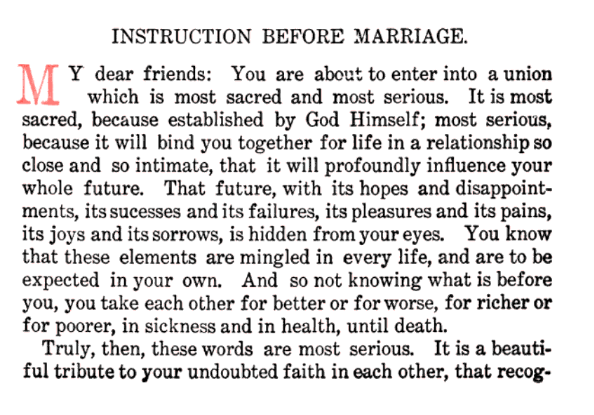
Caption: Sacristy Manual’s marriage exhortation (1905)
If you flip through older ritual books and prayer books, you may see a marriage exhortation, read by the priest to the couple. As with many wedding customs, it’s a variable custom, but generally it takes place right after the couple enters the church, and right before the Rite of Marriage starts.
4. Hand fasting
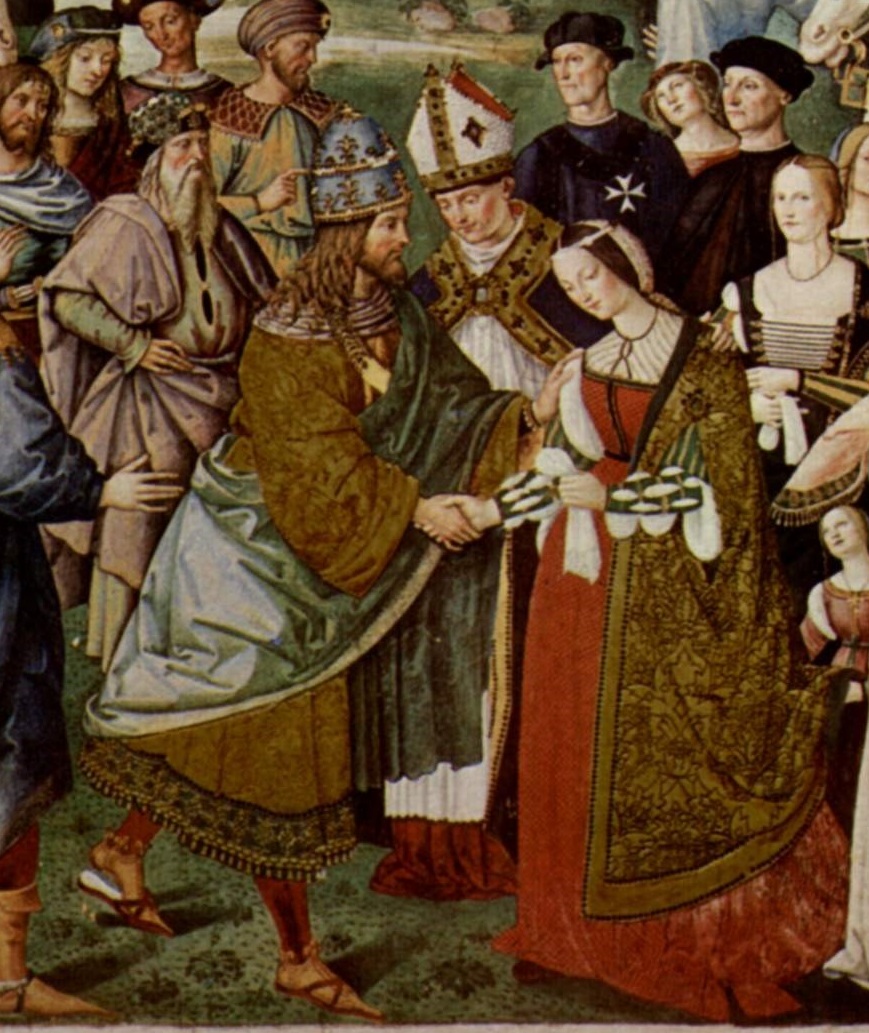
Caption: Bernardino di Betti (1454-1513), Enea Silvio, vescovo di Siena, presenta Eleonora d’Aragona all’imperatore Federico III (1502-1507), fresco. Libreria Piccolomini, Siena, Duomo
If you want to put the Roman in Roman Catholic, look closely at the rubrics in certain rituales for the Rite of Marriage. You’ll see a direction to the priest, for him to wrap his stole around the couple’s left hands. This custom, also called hand-fasting, can be traced back at least to Ancient Rome.5 From the Catholic Encyclopedia:
A second survival which appears even in the concise Roman Ritual, is the hand-clasp of the married pair. This was a custom also in the pagan marriage ceremonial of Rome, and it is hard to say whether it comes to us through Roman or Teutonic traditions. Certain it is that the “hand-fast” constituted a sort of oath among most Germanic peoples and was used for the solemn ratification of all kinds of contracts (see Friedberg, “Eheschliessung”, pp. 39-42). In many, and especially the German rituals, the priest was directed to wrap his stole around the clasped hands of the bride and bridegroom while he pronounced some words of ratification. This ceremony may often be noticed in medieval pictures of a marriage, e.g. the “Espousals of St. Joseph and our Lady”. This also is quite probably of heathen origin for we find a reference to something very similar in Arbeo’s “Life of St. Emmeram”, written before the year 800. It contains an account of a pagan woman summarily given in marriage to a Christian, her hand wrapped round with a cloak “as is the custom in espousals”. A most elaborate ceremony of this kind is prescribed in the “Rituale” compiled for the Christians of Japan in 1605. It was noticed above that the “gifta”, or formal surrender of the bride, who thus passed from the “mund” of her father or guardian to that of her husband, was regarded as the most essential feature of Anglo-Saxon nuptials. This left its mark in the Sarum rite, and something of it still survives both in the Anglican and the Catholic ceremonial. In the former the minister asks “Who giveth this woman to be married to this man”; in the latter no question is put, but the rubric still stands “Then let the woman be given away by her father or by her friends”.6
Here are two snippets from German rituales, buttressing the claim that this is at least an old Germanic custom.

Caption: Ordo Administrandi Sacramenta (1836)

Caption: Agenda Bambergen (1587)
You can see the hand clasp or hand fast in the Byzantine rite, at the royal wedding of William and Kate, and in the film AMADEUS.
5. Nuptial Preface
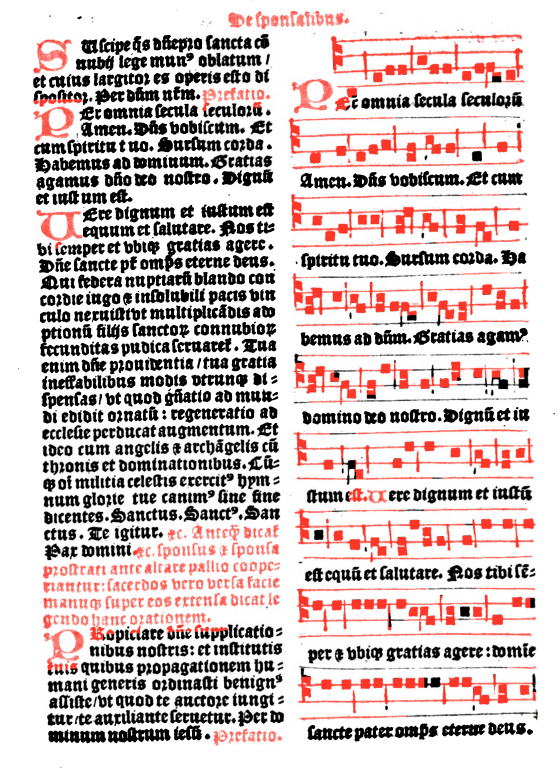
Caption: Missale parvum secundum usum venerabilis ecclesiae Cameracensis. 1507. Shelfmark: BM Lyon, SJ Inc. 317. 31r.
In 2020, the Vatican approved of seven ‘new’ prefaces for use in the Latin Mass. One preface, the Praefatio de Nuptiis, is for wedding Masses, and is quite old indeed.7
Although its use is optional, a nuptial preface is particularly fitting, if one reads Father Nicholas Gihr’s description of the Preface:
Holy Scripture informs us that Jesus Christ “gave thanks” to His Heavenly Father before consecrating the bread and wine, that is, before He changed them into His Body and Blood. Who could fail to understand, even at the first glance, that the Church too herein follows the example of her Divine Lord and Master, from the fact that at the Eucharistic Celebration she places before the act of Consecration the Preface, an incomparably elevated chant of praise and thanksgiving to God? […] According to their text and melody the Prefaces belong to the most solemn, sublime and touching chants of the Church; they are the purest poetry, flowing from the inspiration of the Holy Ghost. The Church is the divinely enlightened proclaimer of the Eternal, she is the Bride of Christ ever in communication with Him, and this communication is a never-ending nuptial celebration in sacrifice and prayer: therefore, speech becomes on her lips a poem, a canticle, having throughout a poetical feature.8 (emphasis added)
6. Nuptial veil
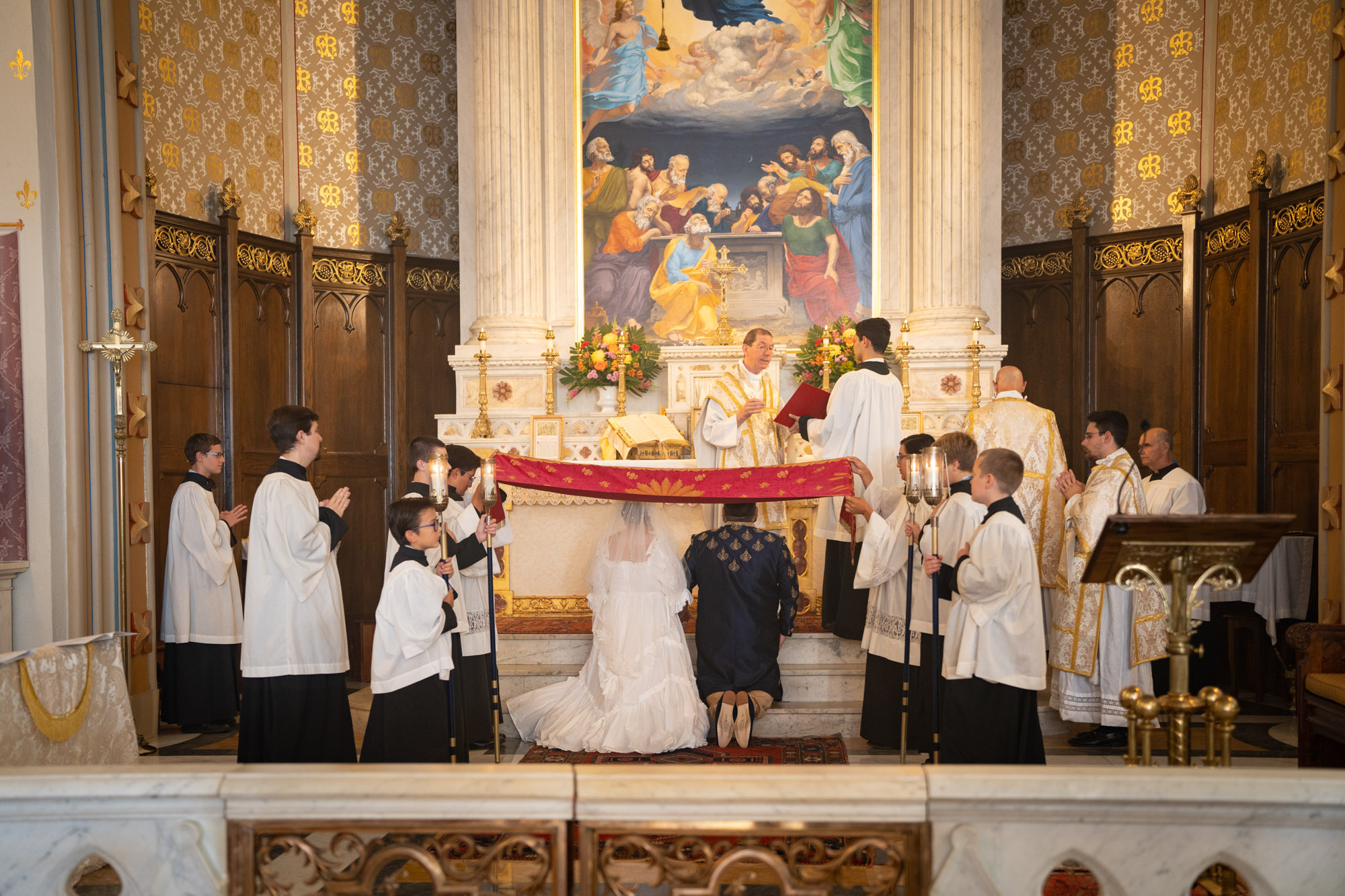
Caption: photo reused with permission from Catherine Asija (2022)
The nuptial veil, or velatio nuptialis, is enjoying something of a renaissance in Catholic weddings lately9. Visually striking, it evokes ancient Jewish customs, Eucharistic processions, and royalty.
7. Flowers
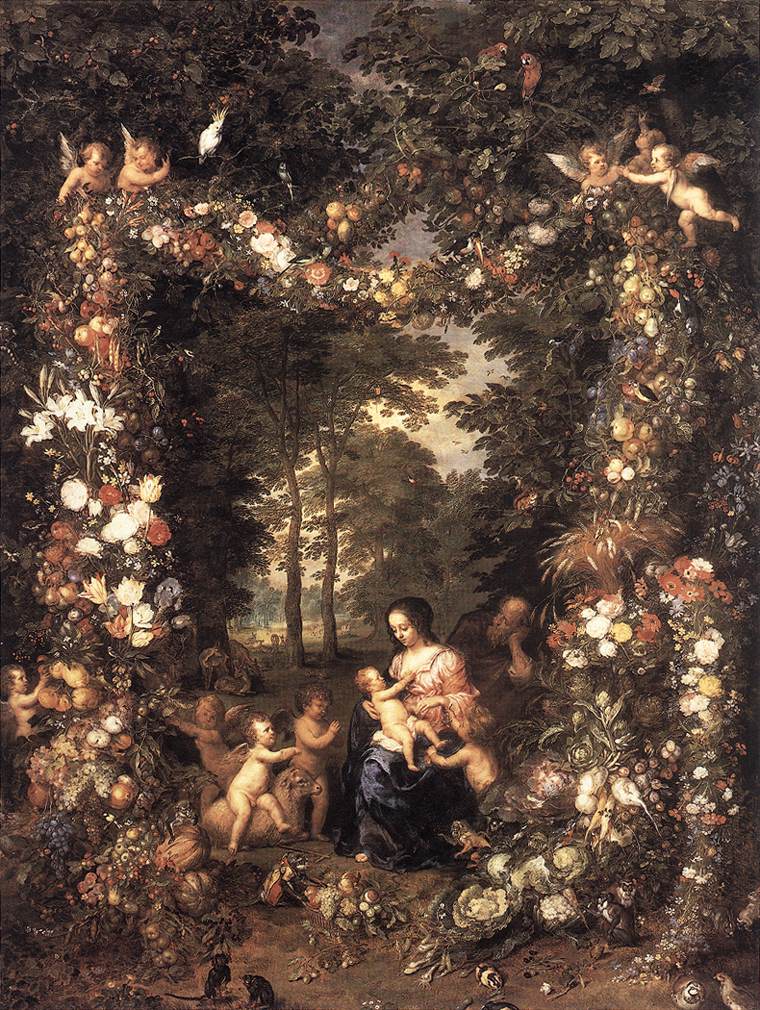
Caption: The Holy Family, Jan Brueghel the Elder
Flowers are one of the most colorful and customizable parts of a wedding day. Every flower comes with a rich history, symbolism, and an array of rubrics and etiquette. Many brides choose to present a bouquet to Mary, after Communion. While not in the official ceremonies, the practice may go back at least several centuries10. Anecdotally, this author can report that a few couples have expanded the practice to include Saint Joseph as well. Mary and Joseph are connected to a vast bouquet of flowers11, and depending on the source and handling of the flowers, wedding day flowers can be incorporated into a Mary Garden12.
8. Blessing of the bedroom

Caption: Blessing of a bedchamber, by Bernard Picart
Most wedding customs spring up from the murky historical past, and are encouraged or tolerated as additional adornments to the official ceremonies. The blessing of the bedroom, benedictio thalami, can claim the rare privilege of being in the Rituale Romanum13. It is probable that this blessing was more common when weddings took place at home.
9. Unity Candle
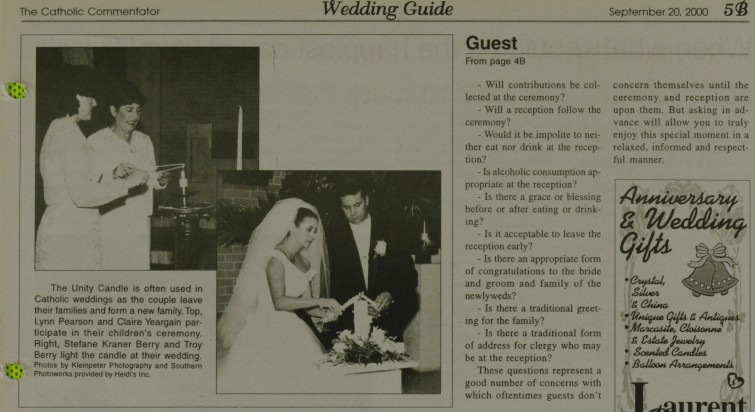
Caption: The Catholic Commentator, Volume 38, Number 15, 20 September 2000. http://thecatholicnewsarchive.org/?a=d&d=CAC20000920-01.2.44.9&srpos=15
Most researchers agree that wedding unity candles did not come into practice before the mid-to-late twentieth century; Father Kenneth Doyle at the Catholic News Service14 wondered if the custom came from the soap opera General Hospital.
Sources
Sharon Kabel. “How traditional are betrothals?” OnePeterFive, Mrach 1, 2022. https://onepeterfive.com/how-traditional-are-betrothals/ ↩︎
From France: Kenneth Stevenson. To join together: the rite of marriage. New York : Pueblo Pub. Co, 1987. https://archive.org/details/tojointogetherri0000stev/page/204/mode/2up?q=%22veni+creator%22. From Poland: See Henryk Sienkiewicz’s novel Children of the Soil and a submission to Latin Mass Weddings from a Polish reader: “Wedding Customs from Poland,” June 5, 2022. https://www.latinmasswedding.com/post/polish-customs/ ↩︎
Usuarium has a collection of medieval manuscripts highly organized in many different ways. Here is a list of manuscripts with the Veni Creator used in the context of laying a foundation stone: https://usuarium.elte.hu/indexlabel/51/view. ↩︎
McNabb, Vincent. “Veni creator spiritus.” Life of the Spirit (1946-1964) 2, no. 23 (1948): 473–78. http://www.jstor.org/stable/43703019. ↩︎
“Ancient rites Christianized by Church.” Catholic Sentinel, February 12, 2013. https://web.archive.org/web/20180801192603/https://catholicsentinel.org/Content/News/Local/Article/Ancient-rites-Christianized-by-church/2/35/20553 ↩︎
Thurston, Herbert. “Ritual of Marriage.” The Catholic Encyclopedia. Vol. 9. New York: Robert Appleton Company, 1910. http://www.newadvent.org/cathen/09703b.htm. ↩︎
“A New-Old Preface for Latin Mass Weddings.” Latin Mass Wedding, March 26, 2020. https://www.latinmasswedding.com/post/preface/ ↩︎
Gihr, Nikolaus. 1949. The Holy Sacrifice of the Mass: Dogmatically Liturgically and Ascetically Explained. St. Louis: B. Herder. ↩︎
“Velatio Nuptialis.” Latin Mass Wedding. https://www.latinmasswedding.com/velatio-nuptialis/ ↩︎
“Weddings and Flowers to Mary.” University of Dayton. https://udayton.edu/imri/mary/w/weddings-and-flowers-to-mary.php ↩︎
Kosloski, Philip. “5 Flowers connected to the Virgin Mary.” Aleteia, August 15, 2017. https://aleteia.org/2017/08/15/5-flowers-connected-to-the-virgin-mary/. See also: Smith, Amy. “A Garden for Mary: Marian Flowers Foster Love for the Blessed Mother.” NC Register, June 12, 2021. https://www.ncregister.com/features/a-garden-for-mary-marian-flowers-foster-love-for-the-blessed-mother. See also: “Saint Joseph Lily.” University of Dayton. https://udayton.edu/imri/mary/s/saint-joseph-lily.php ↩︎
“Mary Garden: University of Dayton.” University of Dayton. https://udayton.edu/imri/mary/m/mary-garden-university-of-dayton.php ↩︎
“Benedictio Thalami.” Latin Mass Wedding. https://www.latinmasswedding.com/benedictio-thalami/ ↩︎
Father Kenneth Doyle. “What’s with the unity candle in a Catholic wedding?” Catholic Philly/Catholic News Service, September 21, 2012. http://catholicphilly.com/2012/09/catholic-spirituality/whats-with-the-unity-candle-in-a-catholic-wedding/ ↩︎